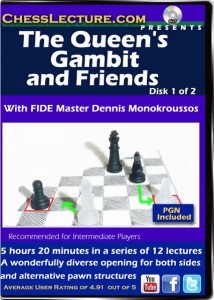New Chess Videos for July 7 – July 11
Monday, July 7 IM Valeri Lilov The Balance Between Attack & Defense (strategy, middlegame) Being able to balance between attack and defense is one of the hardest parts for any chess player. Choosing the right pace and timing to strike or simply make a prophylactic move seems way too complicated. The truth is that there are some fundamental principles that can help you to stay on track with your attack while at the same time, you can check your opponent’s possibilities and counterplay. What are the right steps? Study IM Valeri Lilov’s lecture to learn more.
Tuesday, July 8 GM Leonid Kritz Second Loss of New World Champion (tactics) This game is especially interesting because we can observe how the new world champion attempts to take revenge after his loss against Caruana. The strategy Carlsen choose was simple – get out of the way of theoretical variations and try to play a complicated position. With white, not a really good choice. Radjabov equalized after 15 moves and got superior position which he then converted to a full point. Pretty complicated game and a good idea of how to play against 5.Nge2 King’s Indian.
Wednesday, July 9 FM Dennis Monokroussos From Athens with Love (openings, tactics) Unless we’re grandmasters ourselves we probably all dream of beating a grandmaster in tournament play, and while we’re dreaming we might as well add that we should do it in style. For many of us we must accept the dream in attenuated form: maybe a win in blitz or in a simul. For a fortunate few, the dream comes true in all its glory, as it did one day in 2004 for Angelos Tzermidianos. His brother is an IM best known for an excellent book on the Tarrasch French, but Angelos is a good but untitled player. On that one happy day, however, the dream came true, as he unleashed a cavalcade of attractive sacrifices on his poor victim, Grandmaster Dmitry Svetushkin. Tzermiadianos did have a bit of trouble finishing his opponent off, but eventually succeeded, and the game is worth seeing both in its own right and for its inspirational value.
Thursday, July 10 IM David Vigorito Waving a Red Flag at a Bull (opening, tactics) Black is forced to move his king early in an innocent looking Caro-Kann. While the Black position is tenable, it only takes a couple of small inaccuracies from Mamedyrov and Nakamura is all over him. Black’s opening is probably ok, but the margin for error is small.
Friday, July 11 LM Dana Mackenzie Terrific Teens Episode 3: The Next Polgar Sisters? (middlegame, endgame) In the 2014 U.S. Women’s Championship, 13-year-old Ashritha Eswaran made a splashy debut with a sensational first-round victory over Viktorija Ni. The game highlights her aggressive counterattacking style, her tactical awareness, and her calm approach to an ultra-sharp position. First she sacrifices a queen to derail Ni’s attack; then she outplays Ni in an exchange-down endgame, with a winning move that even the grandmasters commenting on the game overlooked. And by the way… Eswaran has a younger sister who is progressing at least as rapidly as she did! I’m sure I won’t be the last to compare them to the Polgars.



